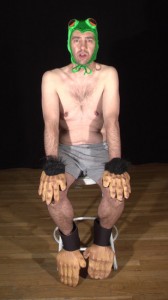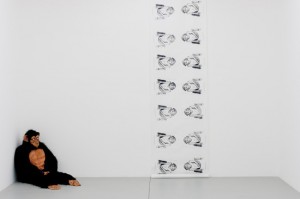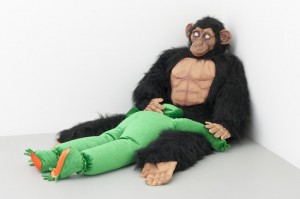OMG
Tony Schwensen’s exhibition at Kalimanrawlins is based on a YouTube meme: a chimp, in the Honolulu Zoo, fucking a live frog that had hopped into his enclosure. Over five million hits. The YouTube video is an unshockingly blurry depiction of its title: Video what the hell another freaky monkey rapes frog orally!. One of the works in Monkey business I is a video of Schwensen sitting on a stool, po-faced and dressed in the hands and feet of a guerrilla costume and a frog hat/mask, repeating the words, ‘I’m a human being, I’m a real human being’. Monkey business I employs meme as motif, where Schwensen has submitted the chimp clip to graphic reinterpretation, to slowing down, to further repetition, and moreover he has trussed it to art history.
The meme works like an evanescent Venn diagram that locks into a cross-section of pop cultural, social and/or political situationism and holds attention for a tiny blip of time. Part of the ‘value’ of the meme is an account of exactly how much attention it holds—which is trackable on the YouTube ‘views’ counter or its visibility more broadly (as a catch-phrase or as an image printed on T-shirts). So any humanity and perhaps possible resonance in the meme subject becomes squeezed out in deference to the numbers who have ‘viewed’. A meme is an ultimate one-time-only one-liner.
In a statement (downloadable on the Kalimanrawlins website), Schwensen writes about his ‘intrigue’ in relation to the video and the further research it inspired him to undertake. This way of looking appears plainly antithetical to the meme’s function in our (collective) psyche. Schwensen also declares that he has watched the video almost daily for the past two years.
Walking through Michelle Ussher’s dense, narratively embedded and symbolically encoded psychological portraits in the larger front gallery, with Schwensen’s soundtrack undermining its logic, made for an absurd and funny reading of the obfuscatory. In some ways, where Ussher’s and Schwensen’s approaches meet is where we, as viewers, end up holding information we shouldn’t. Because we are inadvertently drawn into an information chain, where ‘intrigue’ is a congealing of the repellant and the compulsive.
I went to see a band play recently; two accompanying cage dancers moved constantly and rhythmically throughout their two-hour set. Two sets of almost identical hips, waggling centrifugally and compelling us, the audience, into hypnotic, less well-practised mirrored action. A friend I was with vaguely knew one of the dancers, and, interrupting my transfixed state, told me not the dancer’s name, but that she was in psychoanalysis. At the time I tried to calculate how many hours of dancing might equate to the cost of one session.
Tony Schwensen, Monkey business I, Kalimanrawlins, Melbourne, 2–30 June 2012.


